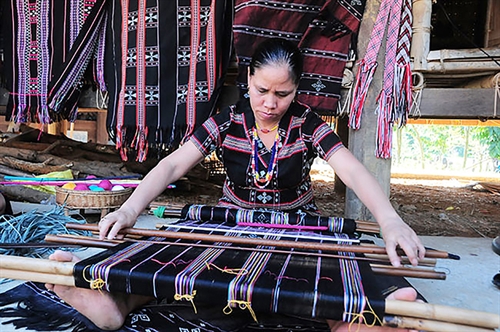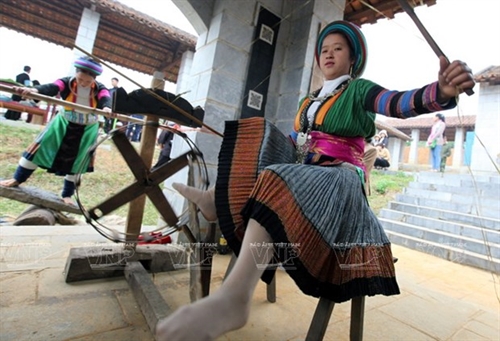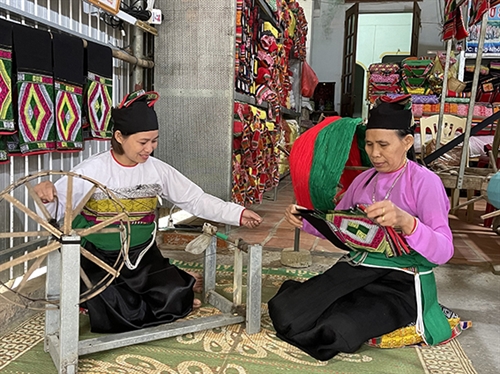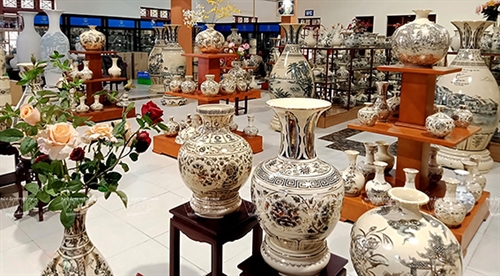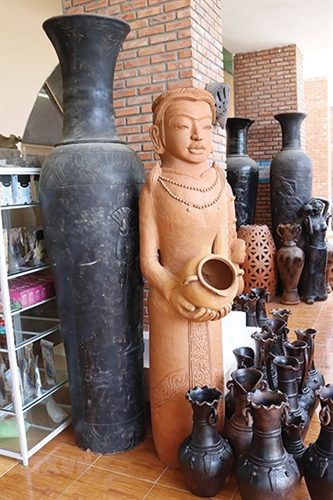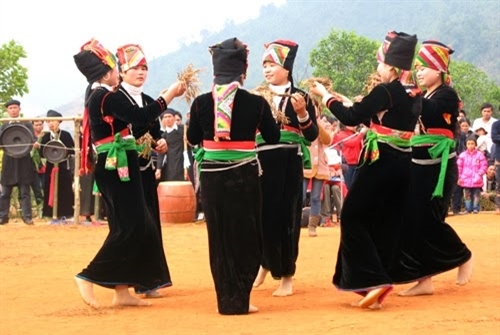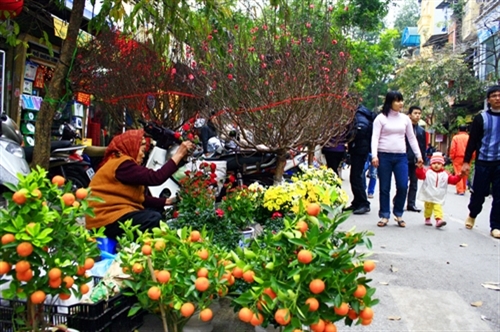Accredited as an UNESCO Intangible Cultural Heritage of Humanity, the art of Xoe or Xe, which means dance in Thai language, is a unique form of traditional dancing imbued with cultural identity of Thai people in northwestern provinces of Lai Chau, Dien Bien, Son La and Yen Bai. With movements describing human daily-life activities, Xoe has long been an indispensable part in the Thai’s cultural and spiritual life. It is performed at all important events of the Thai, ranging from weddings and funerals to village festivals and community cultural activities. Xoe music conveys the Thai’s worldviews and their outlook on life in heaven, on earth, and of the deities. Xoe also expressed Thai people’s wishes for help and blessing from the deities for a peaceful and prosperous life.
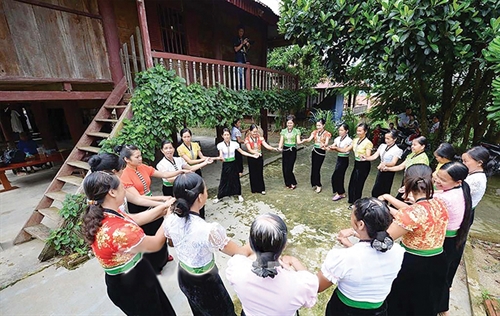 |
| Thai women in Nam Hang commune, Nam Nhun district, Lai Chau province perform Xoe dance__Photo: Thanh Ha/VNA |
No one knows exactly when and where Xoe originated but from time immemorial, Thai people have folk songs:
“Without Xoe, crops cannot grow well
Without Xoe, harvest will fail
Without Xoe, flowers will become withered
Without Xoe, boys and girls cannot fall into love with each other...”
It is believed that Xoe took shape at the very early times. Every time after accomplishing a great deed, conquering a nature’s challenge or beating an enemy, Thai people, regardless of their age and gender, often held hands together and danced around the fire or a tree, called cay xen xinh, which is made of bamboo pillars and decorated with bamboo or wooden animal effigies, colorful ornaments and fruits. This activity was repeated again and again and the dance moves were step by step developed into Xoe as at present. Many traditional dances describe everyday activities such as clearing land for rice cultivation, collecting water and offering wine. Although simple, most of traditional Xoe dances express the Thai’s wishes for community health and harmony.
Xoe basic movements include raising and opening their hands, then lowering them and clasping the hands of the adjacent person. The dancers follow the sounds of different traditional musical instruments that are played in 2/4 or 4/4 time signature to symbolize the souls of the heaven, earth and human while slightly arching the chest and leaning backward. These instruments include tinh tau (gourd lute), ken loa (traditional trumpet), khen be (pan-pipe) drum which is considered the sound of the earth, chieng (gong) whose sounds are regarded as the echo of the heaven, chum choe (cymbal) - the symbol of the birth of all species), mak khinh (small copper balls) and other wind instruments such as pi pap and bang bu. The instrumental music blends with songs and the jingle of the silver jewelry worn around the waists of Thai women. Xoe dance is believed to help people forget the fatigue of daily life and make them love their life and work more. Through these dances, people become closer, more united and more attached.
Xoe dances may be divided into three main types - ritual, circle and presentational. The ritual and presentational Xoe are often named after props used during the performances such as Xoe khan (dance with scarves), Xoe non (dance with conical hats), Xoe quat (dance with fans), Xoe sap (dance with bamboo poles), Xoe qua nhac (dance with small copper balls), Xoe gay (dance with sticks), and Xoe hoa (dance with flowers).
The most popular form of Xoe is circle Xoe, a collective dance which is usually performed in festivals such as the lunar New Year. Dancers stand in a circle, hand in hand, move to the sound of traditional music in a friendly, happy and sociable atmosphere. The circle will be gradually expanded when more people join the dance.
There are six traditional dances of Xoe, of which the most basic dance is Xoe kham khen (hand-held dance), i.e., everyone holding each other’s hands and dancing around a fire or a tree in a counter-clockwise direction. The dance also demonstrates solidarity and cohesion in the community, conveying the message that let’s dance together to celebrate joy, hold hands and work together to overcome difficulties.
Kham khan moi lau is another ancient dance in which female dancers dance with scarves offering rice wine to guests. Kham khan moi lau dance shows the hospitality of the Thai who always welcome their guests in a respectful and sincere manner.
The third dance of Xoe is called pha xi that describes ups and downs in life and Thai people and their efforts to overcome difficulties. To perform pha xi dance, dancers, who are standing in a big circle, move in a clockwise direction to create five small circles which look like a Bauhinia variegata flower, a very popular tree that beautifully blossom in the spring in the Northwest, and represent the four corners and the center of the earth. These circles are sometimes turned into squares, rhombuses and parallelograms. This dance expresses the Thai’s love for their fatherland. Wherever they go, they will never forget their roots.]
 |
| Thai people dance around cay xen xinh__Photo: Vietnam National Institute of Culture and Arts Studies |
The fourth traditional dance of Xoe - nhom khan or pieu scarf tossing dance - is the most jubilant and bustling dance with traditional pieu scarves of Thai women considered the soul of the dance. Born with the development of the group’s traditional brocade-weaving craft, Thai people perform nhom khan to celebrate bumper crops, weddings or new houses. With diverse colors and sophisticated patterns, tossed pieu scarves not only express Thai people’s joy but also reflect dexterity, aesthetic sense and characters of Thai women.
Don hon (stepping up and down) dance is another dance of Xoe. Dancers also stand in a circle and move clockwise but when a dancer steps up, two adjacent dancers will step down. The dance conveys a message that although life is full of ups and downs and no matter how things change, everyone still unites with strong beliefs and unchanged wills and emotions.
The last dance to mention is om lom top mu (clapping hands while walking in a circle) which is usually performed to wrap up a celebratory event. The dance reflects joy and happiness. Dancers move in the clockwise direction, are full of joy and cheer when the night falls, bid farewell to each other and welcome a new day.
Handed down from generations to generations within families, dance troupes and schools, Xoe has become a symbol of hospitality and an important cultural imprint of the Thai in the country’s northwestern mountainous region. The dance symbolizes the beauty and represents the artistic values of dance, music, singing, costumes, cuisine and more importantly the culture of Thai people.- (VLLF)
